Ensignette No 1
Houghtons Limited
| Name / Model: | Ensignette No 1 |
| Manufacturer: | Houghtons Ltd. |
| Country of Origin: | United Kingdom |
| Construction: | Bedless strut camera. The early pattern body was made of brass; the later pattern body was made in aluminium with nickel-plated fittings. |
| Plate / Film Size: | 1½ x 2¼ rollfilm (e.g. Ensign 1E) |
| Movements: | None |
| Dimensions (w x h x l): | |
| Production Period: | 1909 - 1927 |
The Ensignette was designed by the Swedish Engineer Magnus Neill, who was also responsible for the design of the pocket watch camera called the 'Ticka' that was manufactured in Britain by Houghtons Ltd. Neill patented the design for the Ensignette in 1907; this date appears on the front of the camera. The camera was not introduced to the market at the end of 1909.
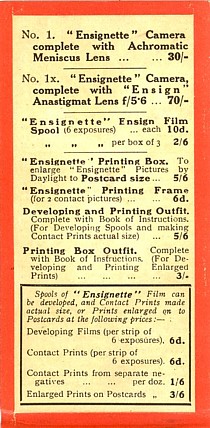 |
|
 |
The first models were made of black enamelled brass with nickel plated fittings. There were two models initially, as shown in the price list on the left, which was included in the base of the box with the No 1 camera (#544) in my collection. The No.1 was equipped with an f/11 Achromatic Meniscus lens for 30/- and a No.1x with an "Ensign" Anastigmat lens f/5.6 for 70/-. These two models were joined by two further variants, the Ensignette No.1b with a Cooke Anastigmat f/5.6 for £4-10-0 and a Ensignette No.1g with a Goerz Syntor f/6.8 for £5-10-0. These had an improved three speed shutter rather than the simple single speed (instantaneous and timed) of the initial models. None of these models had any provision for focusing. Other variants were introduced later. |
Early in 1912, presumably encouraged by the success of the Ensignette and the growing popularity of small pocket sized cameras, Houghtons introduced a new version. This new model was called the No.2 Ensignette, which took six pictures of a larger size of 3x2 inches on a new size of roll film 2E.
In about 1920 the design and manufacture was changed to use aluminium for the bodywork in place of brass.
According to Adrian Richmond's research (http://www.ensignphotographic.com/ensigncamerapage.htm, last accessed Feb 27, 2022), in 1927 the Ensignette disappeared altogether from catalogues of the newly formed Houghton-Butcher company. This decision must have been influenced by the fact that they had lost the battle with Kodak over film format. Houghton-Butcher conceding this by discontinuing the Ensignette in favour of the Vest Pocket Ensign (basically the same form as an Ensignette that used 127 film).
More history of the Ensignette cameras and its manufacturer Houghtons (later Houghton-Butcher) can be found on Adrian Richmond's excellent web site at http://www.ensignphotographic.com/ensigncamerapage.htm.
The picture below shows a no 1 Ensignette alongside the larger No 2 Ensignette for comparison.
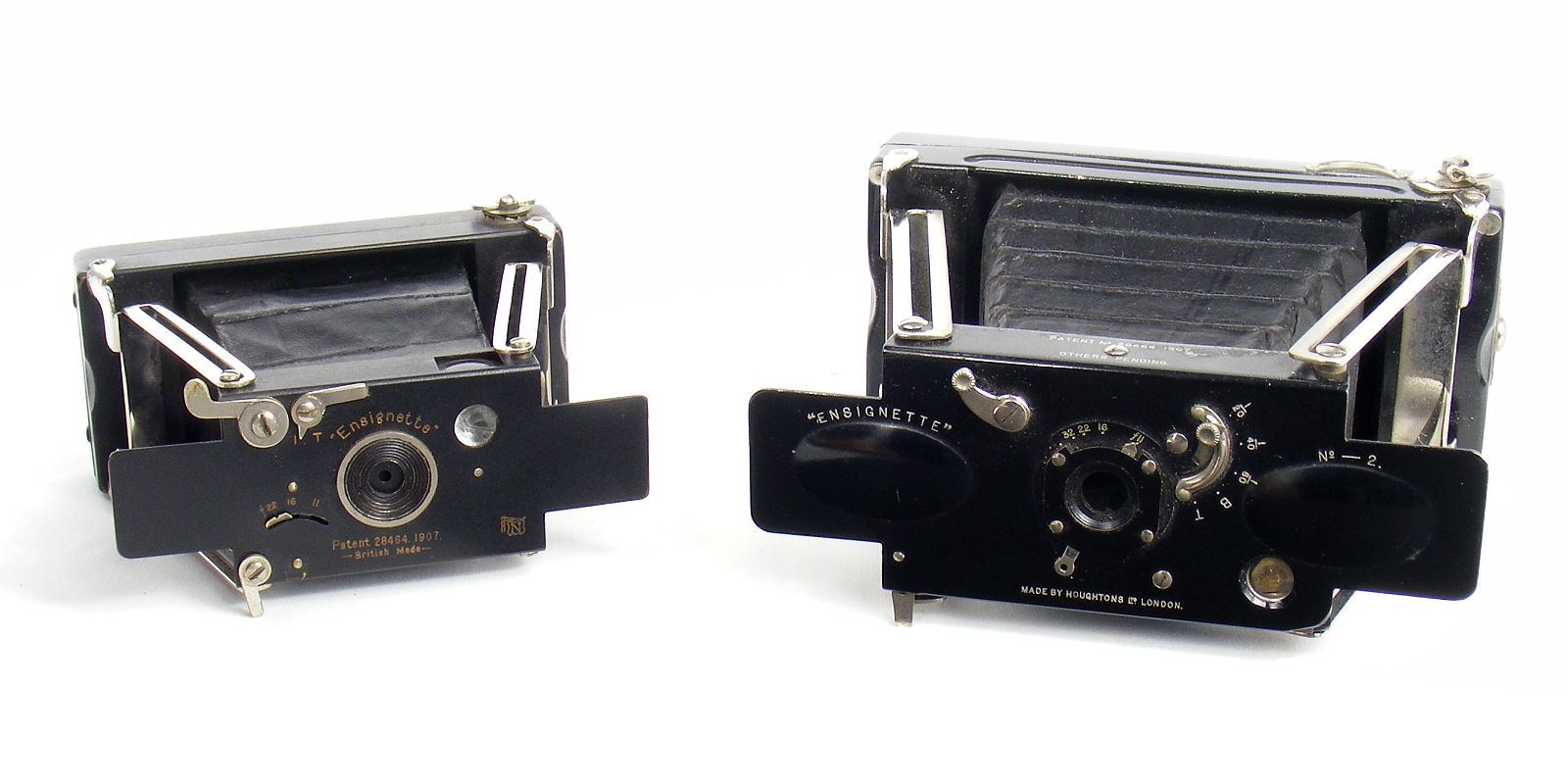
| Model / Variant | Ensignette No. 1 |
| Lens: | Achromatic Meniscus f11 |
| Shutter: | Single speed (I & T) |
| Date of this Example: | c1909 |
| Serial Number: | Serial 2366 stamped into inside narrow edge of back. |
| Availability: |
|
| Inventory Number: | 544 |
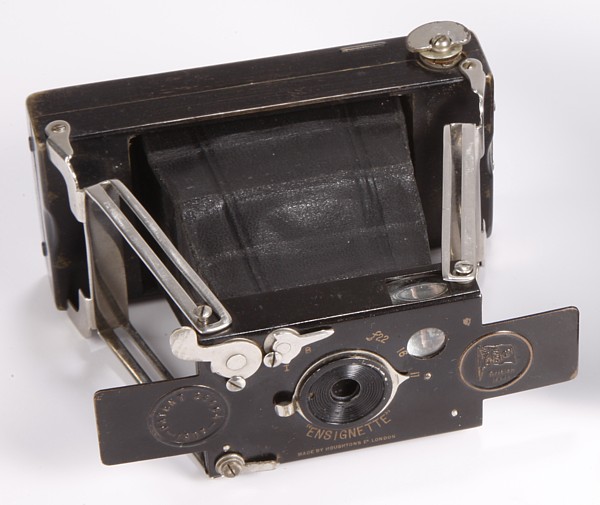
(Image © Amateur Photographer 2010, taken for an article by Ivor Matanle and reproduced with kind permission)
Description
Brass body, with smooth matt enamel finish. This is the first model with the plain front and N-sign symbol and is therefore dated between 1909 and 1911. This camera is in near-mint condition and appears to have had only very limited use (slight scratching in film chamber suggests that a film may have been put through it). The pleated bellows in excellent condition and the shutter still works. There is only very slight tarnishing to the brightwork.
The lens itself has three aperture settings, set by a slider adjacent to the lens.
The camera came with its original box (again the N-sign symbol is repeated on the box cover), with all its paperwork (instructions, short instruction sheet / price list). There is also a thin envelope folded up inside with an Italian addressee (the camera came from Italy), a fold of paper containing what looks like a washer from beneath the winder and a small piece of cloth - purpose unknown!
I speculate that perhaps the winder broke when the camera was first used; it was repaired but then stayed in its box thereafter? Maybe!
~ # ~ # ~
| Model / Variant | Ensignette No. 1 |
| Lens: | Achromatic Meniscus f11 |
| Shutter: | Single speed (I & T) |
| Movements: | None |
| Date of this Example: | c1918? |
| Serial Number: | Serial D19710 inside back |
| Availability: |
|
| Inventory Number: | #542 |
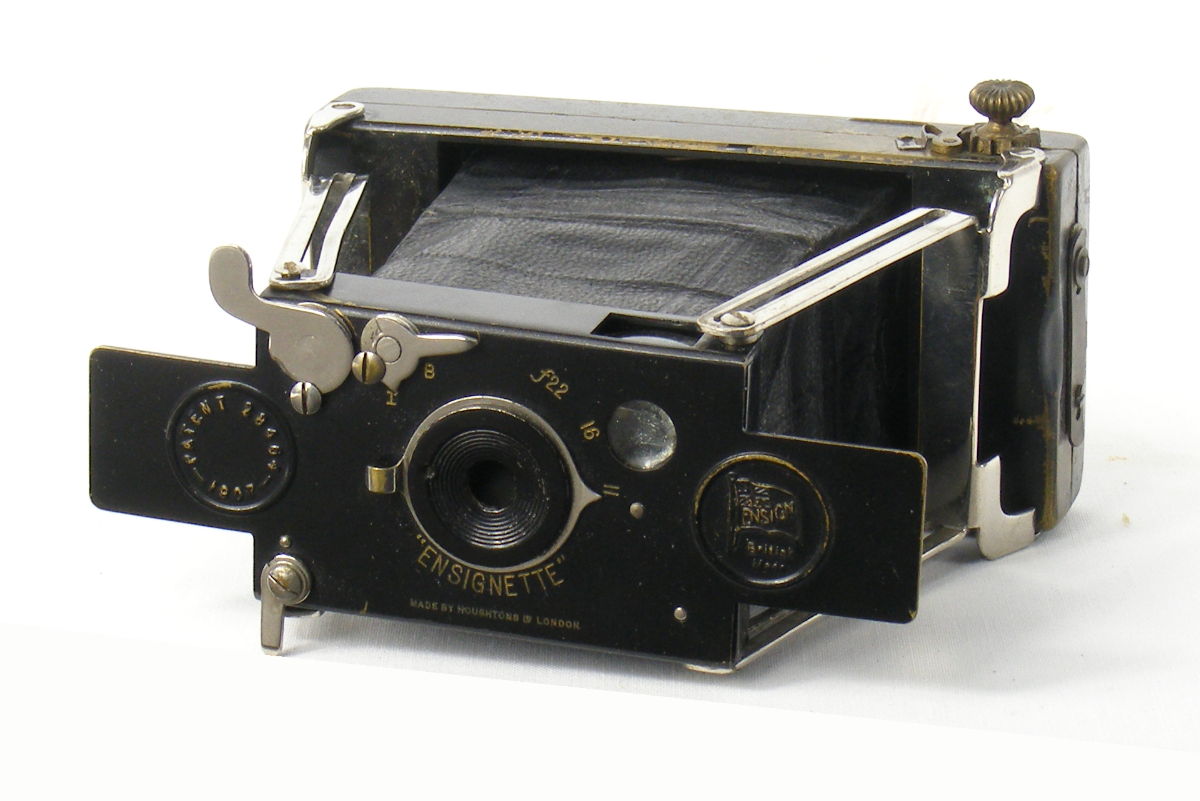
Description
Brass body, with smooth enamel finish. Well used condition overall, with substantial brassing on edges and back. Pleated bellows in good condition, but holed at corner folds. Shutter still works.
This brass bodied variant was made from 1912 - 19, when the body material switched to aluminium. Date of this example set on the basis of the high serial number (but it is a guess).
The lens itself has three aperture settings, set by a pointer ring around the lens.
The winder on this version is unusual. Rather than the usual key, it is a knurled brass knob with an exposed ratchet mechanism. It appears to be original, but I have not seen another one like it.
~ # ~ # ~
| Variant | Ensignette No. 1G De Luxe |
| Lens: | Goerz Dopp.-Anastigmat F6.8 |
| Shutter: | 3 speed (1/20 - 1/60), B & T |
| Date of this Example: | c1911? |
| Serial Number: | Serial 5027 inside back |
| Availability: |
|
| Inventory Number: | 488 |
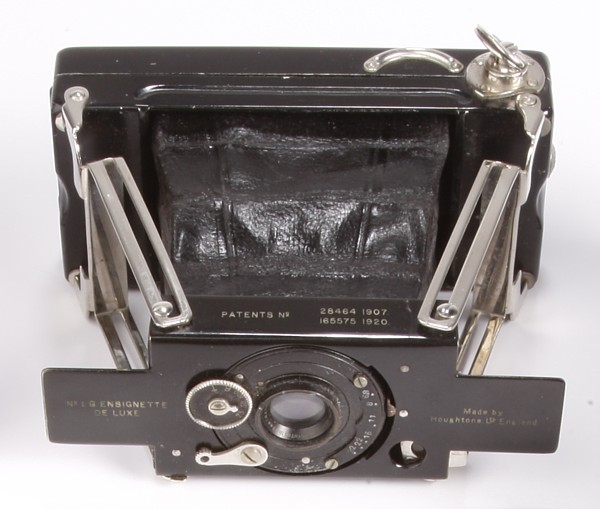
(Image © Amateur Photographer 2010, taken for an article by Ivor Matanle and reproduced with kind permission)
Description
This Ensignette No 1G De Luxe camera is equipped with a high quality Goerz lens and 3-speed shutter. The camera has an aluminium body, with smooth enamel finish. It has the simpler flat pleated bellows. Very good condition overall, with no obvious flaws. This variant does not appear in McKeown.
Inside the back is an orange label that warns the user to employ the spool holders supplied with "this new model camera" and discard any provided with the film.
~ # ~ # ~
| Variant | Anastigmat Ensignette No. 1D |
| Lens: | Aldis-Plano Anastigmat f6.8 (focussing) |
| Shutter: | Single speed (I & T) |
| Date of this Example: | c1912 |
| Serial Number: | Serial A 6869 inside back |
| Availability: |
|
| Inventory Number: | 435 |
<Photographs to be added>
Description
The Anastigmat Ensignette No. 1D has a brass body, with smooth enamel finish. This example is well used condition overall, with inevitable brassing on edges. There is some corrosion, which has been painted over by a previous owner (and not very well unfortunately).
This is a focussing model with wheel and scale below the lens. The lens itself has three aperture settings, which are rather stiff to set.
This camera is advertised in the 1912 BJPA (see Notes).
~ # ~ # ~
| Variant | Anastigmat Ensignette No. 1B |
| Lens: | TT & H Cooke Anastigmat f5.8 (focussing) Serial 66934 |
| Shutter: | Single speed (I & T) |
| Date of this Example: | c1912 |
| Serial Number: | Serial A 884 inside back |
| Availability: |
|
| Inventory Number: | 642 |
<Photographs to be added>
Description
The Anastigmat Ensignette No. 1B has a brass body, with smooth enamel finish. This example is in very good condition overall, with only minimal brassing on the edges.
This is a focussing model with wheel and scale below the lens. The lens itself has three aperture settings, which are rather stiff to set.
This camera variant is also advertised in the 1912 BJPA (see Notes).
Notes
Some dating information for these cameras can be acquired from the format and materials used, as follows:
- Brass body with N-sign symbol on otherwise flat front: 1909-1911
- Brass body with raised circles on each 'wing' of the front panel: 1912 -1920
- Aluminium body with raised oval shaped lobes on each wing: 1920-1927
The De Luxe and Anastigmat models are less common variants of the Ensignette camera.
The advertisement in the 1912 BJPA (p319) identifies five distinct variants of the Anastigmat Ensignette, as follows:
- No 1n "Ensign" Anastigmat lens f6
- No 1d "Aldis" Anastigmat lens f6.8
- No 1b "Cooke" Anastigmat lens f5.8
- No 1g "Goerz Syntor" Anastigmat lens f6.8
- No 1z "Zeiss Tessar" Anastigmat lens f6.8
All of these Anastigmat models are focusing versions.
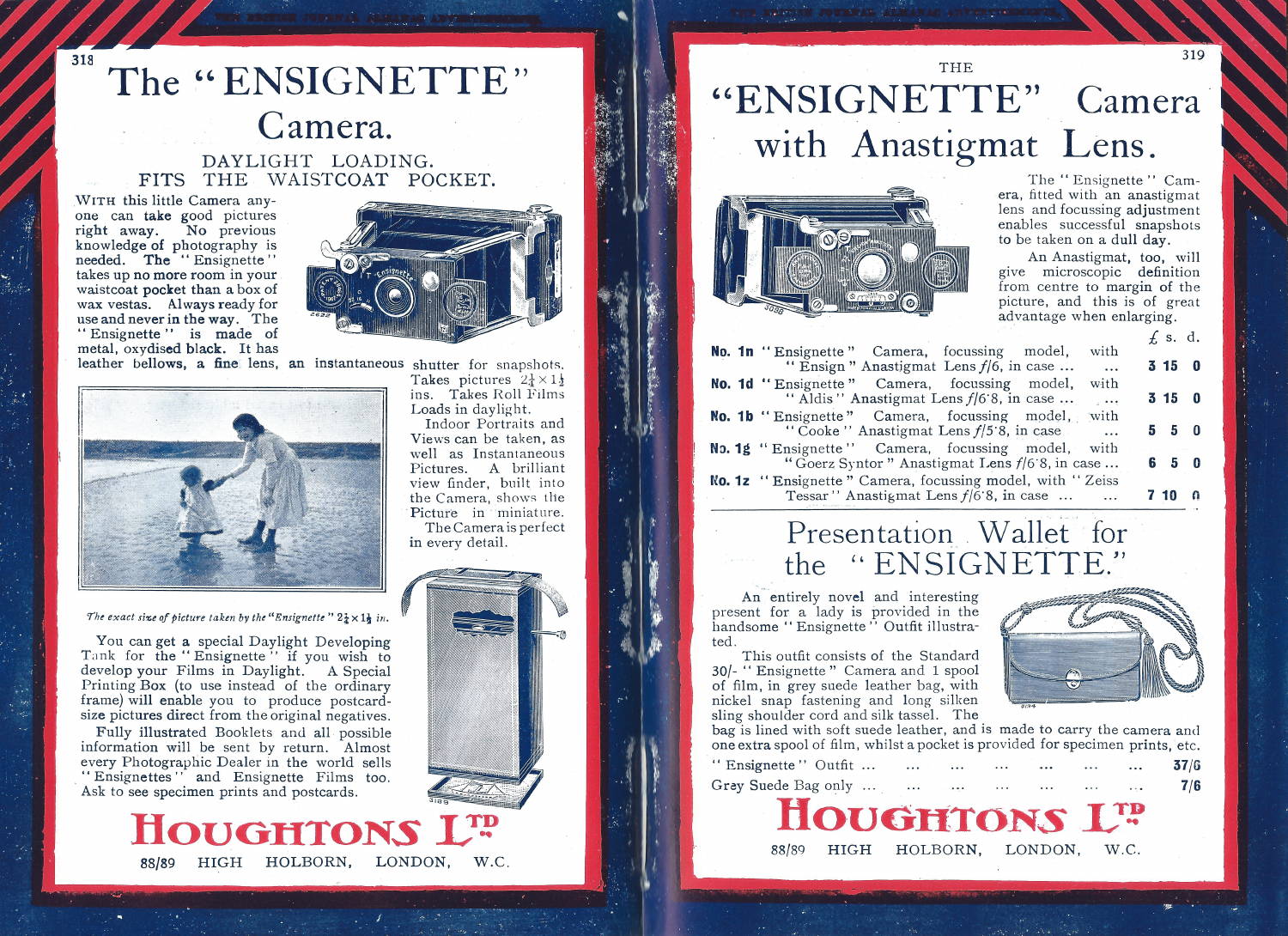
It is a challenge to find the early brass bodied variants in good condition as the black enamel wears off very easily from the soft brass on edges that rub on the case or just through handling. The backs suffer particularly with enamel loss.
![[x]](../../images/checked.png)
![[ ]](../../images/unchecked.png)